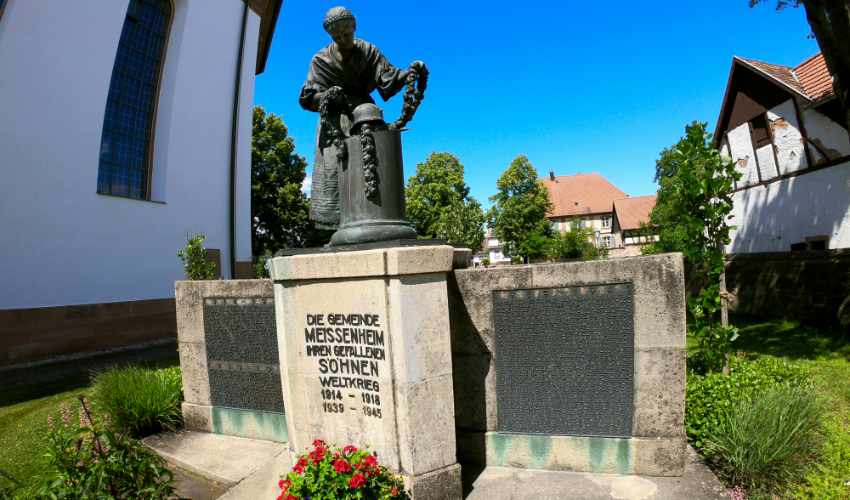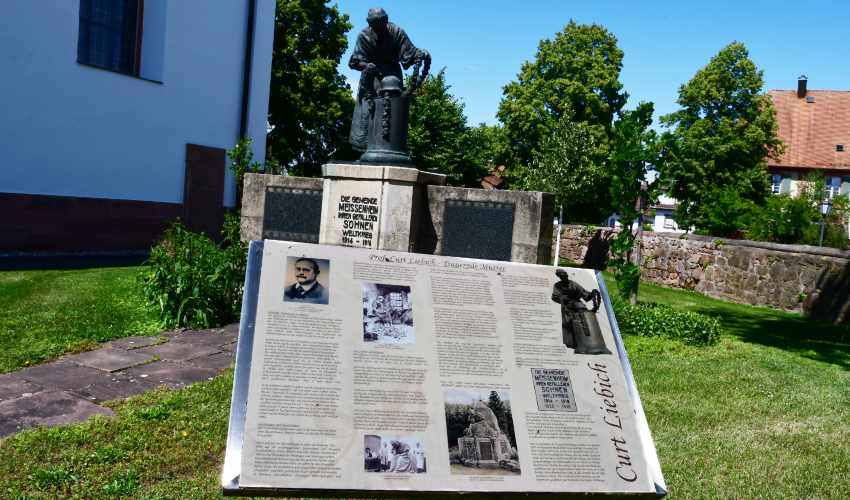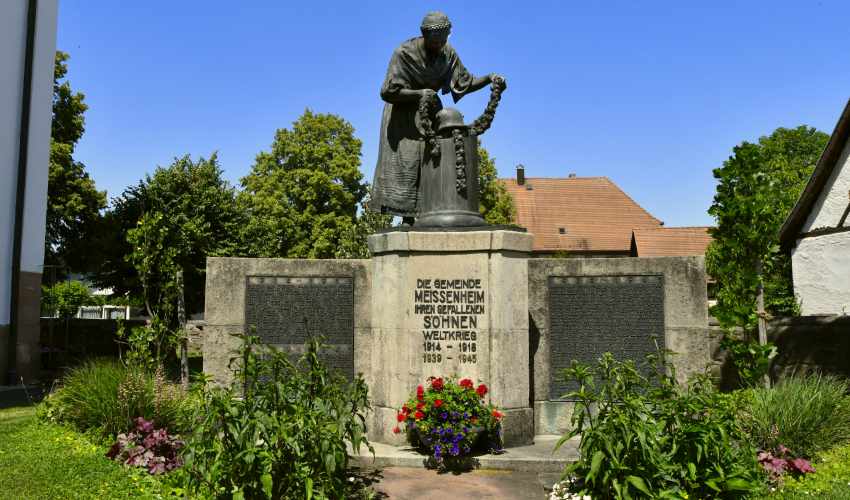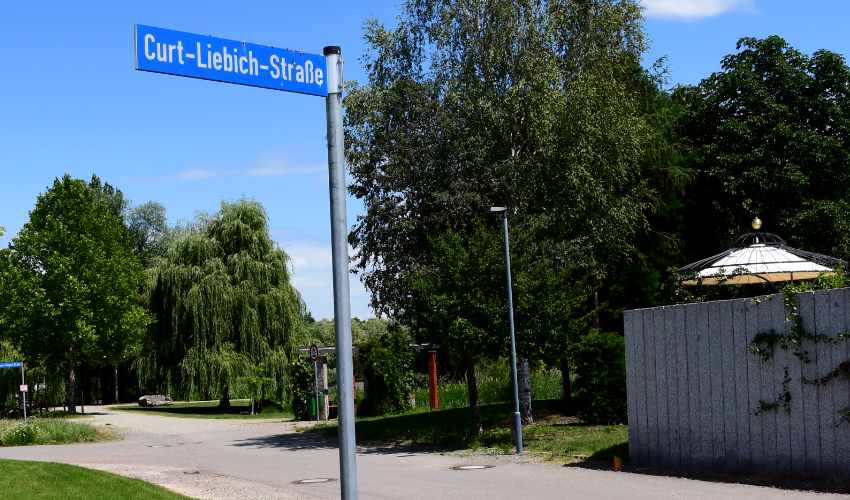
The German painter, sculptor and graphic artist, Curt Liebich was born on November 17th, 1868 in Wesel. Curt Liebich died on December 12, 1937 in Gutach.
Curt-Liebich-Strasse was named after him in the Hellersgrund development area in the municipality of Meißenheim.
The siblings Hanne Neumeister and Georg Liebich were present at the street inauguration in Meißenheim. There are two living grandchildren of Professor Curt Liebich, who designed the memorial next to the Meißenheim church. The grieving girl (from 1930) is a sign of peace.
Curt Liebich as a sculptor
Sculpture was one of the later works of his life. He turned intensively to the plastic of the performing arts in three-dimensional form, only at the age of 55 years again
His first assignment after training as a sculptor in Berlin was given to him in a highly unusual way as an art student in Weimar. The court marshal of the Grand Duke asked him for an artistic contribution to the visit of the German Emperor Wilhelm the Second, in the form of the coats of arms of both royal houses.
After the First World War he designed 10 and 50 pfennig pieces, the Nortgeld for the local area, and created a medal for a rally of the ADAC, among other things.
His sculptural activity began, however, with the bronze relief for the tomb of his first wife.
Death and mourning remained the central themes of his work in this area. In the end, sculpture became his own artistic fate when he was banned from working in this branch in a particularly perfidious manner in the Third Reich. His idea of a memorial as a memorial did not fit into the prevailing ideology, and so he was given his artistic craft according to the practice at the time on the grounds of “professional incapacity”.
It is not just a hallmark of our time that it has a split relationship with the war dead and monuments of all kinds. That was also the case after the First World War.
This split relationship to my own history resonates with me, and so there was also a lot of discussion back then about the right forms in commemorating the fallen, especially in memorials.
According to Liebich’s suggestion, the municipality of Gutach im Kinzigtal took a completely new path in a difficult time, with great financial sacrifices from its citizens, which received attention throughout Germany and in neighboring countries.
It is not heroic pose, hero worship such as war and weapon symbolism, not justification and glorification of human sacrifice through war, which is the focus in one of the usual forms, but grief and suffering in the monumental figure of the bereaved, the surviving victims of the war; the memorial as a memorial also with the silent question about the meaning of the sacrifice of the dead and the bereaved or ultimately about the madness of the war. And so, after the Second World War, it is perhaps even more a reminder for peace than it was then. The monument “the grieving appraiser” includes everything that is typical of Liebich’s art. A figure from the people, the costume as a local and native symbol, granite as local stone, it is all part of the space in which the dead lived and in which the relatives remember them. The whole scenario of moving out and returning home, decorated with flowers at the beginning, but also with the drummer’s death, and at the end with cripples, the anger at defeat, the bad news, is depicted in local figures in the side reliefs, just as it was in the village is, but also symbolic for any other place.
The form and content were by no means undisputed. A! Weibsbild “does not belong on a war memorial, some were indignant at the time. The Gutach community nevertheless opted for Liebich’s design and work. In the first year after its creation, more than 20,000 visitors were counted.
After the Gutacher monument was erected, Liebich received numerous inquiries and orders with the desire for a similar work to commemorate the fallen. The result was a whole cycle of monuments in a related form.
| – | in Gutach with the “grieving Gutacherin” |
| – | in Schappach, “the grieving father at the grave” |
| – | in Rhina at Säckingen, “two war orphans at the father’s grave” |
| – | in Meißenheim, “grieving mother with garlands” |
| – | in Geisingen, “young woman in thoughful pose” |
| – | in Dunningen (Württemberg) on special request one “Madonna as a symbol of the mother and the maternal” |
| – | in Reichenbach bei Hornberg one”domestic scenario in a relief” |
In contrast to many others, Liebich’s monuments have been preserved despite the chaos of the war and the change in political views and, with one exception, are in their original location.
Source: “Gutach / home of the Bollenhut costume, customs and rural environment, artists’ colony”; Reprint approved by the Gutach community.
When creating the memorial for the victims of the World War in the Meißenheim community, Professor Curt Liebich remained true to his ideal. He created not a heroic pose, but a memorial for peace and against war. The mourning girl from the Ried with the traditional costume for the local region. Many also see the girl as the grieving mother or wife who weeps for their fallen son or the man they love.
The Meißenheim parish erected this worthy memorial on the forecourt east of the church in the summer of 1929 for the 54 fallen soldiers of the First World War. The artist Professor Curt Liebich created a bronze statue that stands on a high pedestal and fits in with the overall picture of the complex surrounding Frederike Brion’s grave. A reed girl, in the traditional costume of the village, representing the grieving homeland, puts a wreath of gratitude around the steel helmet of the fallen man on a broken column. This broken pillar is the symbol of the suddenly broken off life. The mourner is framed by the names of the fallen and missing of the two world wars.



